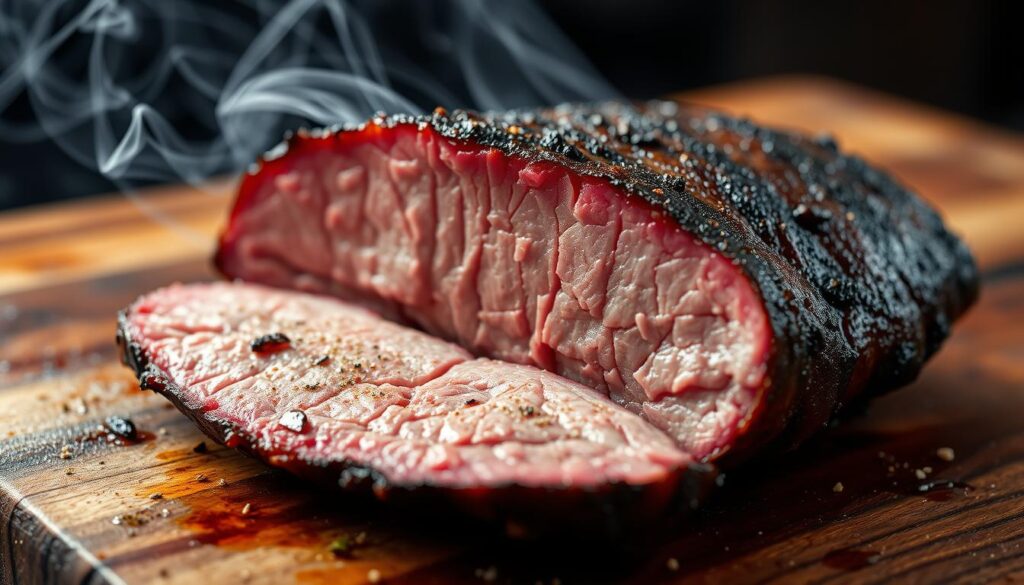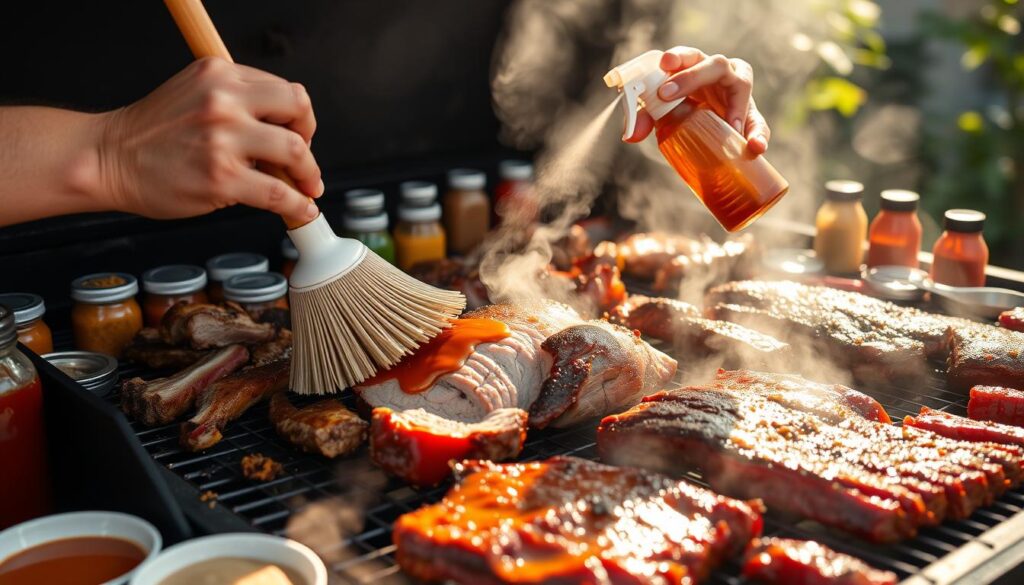How to Build Flavor Layers with Mops, Sprays, and Sauces
Ever wondered how chefs and pitmasters make their grilled and smoked meats so delicious? It’s all about using mops, sprays, and sauces. These tools help create deep, complex flavors. By learning how to baste and glaze, you can improve your outdoor cooking. Every bite will be full of amazing tastes.
This guide will show you how to layer flavors with mops, sprays, and sauces. You’ll learn to balance sweet, savory, and spicy flavors. You’ll also see how to get the perfect bark and smoke ring. These are the secrets pros use to make ordinary meats taste like gourmet dishes.
Key Takeaways
- Unlock the secrets of flavor layering with mops, sprays, and sauces
- Achieve complex, multi-dimensional flavor profiles in your grilled and smoked meats
- Master the art of basting and glazing to take your outdoor cooking to new heights
- Balance sweet, savory, and spicy notes for a perfectly balanced flavor profile
- Discover the techniques that professional chefs use to create mouthwatering results
Are you ready to improve your grilling skills and wow your friends and family? Let’s explore how to make irresistible flavor layers with mops, sprays, and sauces.
The Art of Basting: Why Mop, Spritz, or Baste?
Basting your meat with mops, sprays, and sauces can change the game. It adds layers of flavor and aroma. These techniques also help remove excess spices, reduce shrinkage, and extend cooking time.
Adding Flavor and Aroma
Regularly basting your meat with a flavorful mop or spritz adds layers of taste and smell. The liquid soaks into the meat, making it bold and unique. Your guests will want more.
Removing Flavors and Spices
Strong marinades or spice rubs can overpower your meat. Basting with liquids like apple cider vinegar or broth balances out the flavors. This leaves you with a tasteful and enjoyable dish.
Reducing Shrinkage
Frequent basting prevents meat from shrinking too much. The liquid keeps proteins hydrated and intact. This results in a juicier and more tender final product.
Extending Cooking Time
Regular mopping or spritzing slows down cooking. It helps you achieve the right doneness without overcooking. This is great for larger cuts that take longer to cook.
Learn the details of each basting method to get the best results. Try different mop ingredients and spritz benefits. Find the perfect mix for your basting techniques and cooking time considerations.
Mastering the Mop: Ingredients and Techniques
Making the perfect mop sauce is like an art. It needs the right mix of ingredients and a good sense of flavor balance. Whether you like the zing of vinegar or the sweet taste of fruit juice mops, the secret is finding flavors that match your BBQ.
Choosing Liquids: Juices, Vinegars, and More
The base of any mop sauce is its liquid. Try using different juices like tangy apple cider or sweet pineapple to deepen your mop’s flavor. Vinegars can add a nice acidity. For some heat, add spicy things like hot sauce or chili peppers.
Balancing Flavors: Sweet, Savory, and Spicy
What makes a mop sauce special is balancing sweet, savory, and spicy tastes. Mix things like honey, brown sugar, or molasses for a sweet glaze. Add soy sauce, Worcestershire, or coffee for a savory umami taste. And don’t hesitate to use spices and chilies for extra flavor.
“The key to a truly memorable mop is finding the perfect harmony between sweet, savory, and spicy elements.”
By getting good at flavor balancing, you can take your barbecue to new levels. This opens up a world of delicious possibilities.
Flavor layers with mops and sauces
Discover the secrets of flavor layering with mops and sauces. These tools can turn your grilled or smoked meats into a feast of barbecue sauce reductions and marinade techniques. This makes your meals more enjoyable.
Begin with a tasty marinade. Mix acids, sweeteners, and spices to make a base that infuses your meat with flavor. As it cooks, mop it with a flavorful liquid. This lets the juices soak back in and fills every bite with aroma.
The real magic is in barbecue sauce reductions. Reduce rich sauces to intensify their flavors. Then, use them to baste your meat near the end of cooking. This creates a caramelized, shiny outside that locks in the smoky, sweet, and savory tastes you’ve worked on.
| Mop Ingredients | Sauce Reduction Ingredients |
|---|---|
|
|
With some trial and a lot of love, you can make your own flavor layering methods. This will take your mops and sauces to barbecue perfection.
The Smoke Ring: Enhancing Color and Flavor
The smoke ring is more than just a pretty color. It also boosts the flavor of your barbecue. Let’s dive into how moisture and a chemical reaction between nitrite and myoglobin make it happen.
When meat meets smoke, a cool chemical reaction starts. Nitrogen compounds and oxygen mix with myoglobin in the meat. This mix creates a pinkish-red color, known as the smoke ring. It can go deep into the meat.
Keeping meat moist is key for a great smoke ring. Moisture lets smoke and nitrogen compounds go deeper into the meat. The type of wood, cooking temperature, and how long you smoke all matter for the perfect smoke ring.
“The smoke ring is not just a visual treat, but it can also contribute to the overall flavor profile of your barbecue. Understanding the science behind its formation can help you achieve the perfect smoke ring every time.”
Learning about smoke ring formation can take your barbecue to the next level. It’s great for both experts and backyard grillers. It adds new flavors and textures to your smoked meats.

| Factors Affecting Smoke Ring Formation | Impact |
|---|---|
| Moisture content in the meat | High moisture helps smoke and nitrogen-based compounds penetrate the meat, resulting in a deeper and more vibrant smoke ring. |
| Wood type used for smoking | Different wood types, such as hickory or oak, can produce varying levels of nitric oxide, affecting the smoke ring formation. |
| Cooking temperature and duration | Higher temperatures and longer cooking times can enhance the chemical reactions that create the smoke ring. |
Bark Formation: Achieving the Perfect Crust
Making the perfect barbecue bark is like an art. It’s all about controlling browning, caramelization, and moisture. This crust adds a nice texture and brings out amazing flavors, making your barbecue better.
Browning and Caramelization
The secret to a tasty bark is the Maillard reaction and caramelization. When meat gets hot, sugars and amino acids on the surface react. This makes the meat brown and adds flavors like savory, nutty, and sweet.
Crust Texture: Crispy or Sticky?
What kind of crust you like is up to you. It’s about finding the right balance between dry and moist. A crispy bark needs careful moisture control, letting the surface dry and caramelize. For a sticky crust, keep it moist for a glossy look.
To get the crust you want, pay attention to how you cook and baste your meat. Try different rubs and sauces to find the best mix for your barbecue.
“The perfect bark is the culmination of a lifetime of barbecue mastery, where every element – from the rub to the cooking technique – comes together in harmonious perfection.”
Timing is Everything: When to Mop or Spritz
Timing is key when making delicious flavor layers on grilled or smoked meats. Knowing the best mopping and spritzing times helps achieve perfect crust formation and temperature considerations.
Start basting your meat once it starts to form a crust. This usually happens after 30-45 minutes of cooking, depending on the meat’s size and type. Mopping too early can mess up the bark. Waiting too long can leave your meat dry and flavorless.
- Mop or spritz your meat every 30-45 minutes after the initial crust has set, being careful not to remove too much of the rendering fat and juices.
- Pay close attention to the temperature of your grill or smoker, adjusting as needed to maintain the ideal environment for crust formation.
- Experiment with different mopping and spritzing intervals to find the perfect rhythm for your specific recipe and cooking setup.
Mastering when to mop and spritz will help you make the most flavorful and visually stunning smoked or grilled meats your guests have ever had.

“The secret to the perfect bark lies in the rhythm of your mop or spray bottle.”
Mopping vs. Spritzing: Pros and Cons
Choosing between mopping and spritzing can change how your barbecue tastes and how long it cooks. Both methods have their own benefits and things to think about. Let’s look at what makes each one special to help you pick the best for your meal.
Flavor Impact
Mopping puts a liquid directly on the meat, giving it strong flavors. This method is great for those who want a bold taste. On the other hand, spritzing uses a spray bottle to add flavor. It gives a light, even taste and a nice smell to the meat.
Cooking Time Considerations
How long it takes to cook is important when deciding between mopping and spritzing. Mopping can make cooking longer because the meat absorbs the liquid. This is good for tougher meats that cook better slowly. Spritzing doesn’t slow down cooking much because the liquid evaporates fast, keeping the cooking time steady.
Choosing between mopping and spritzing depends on what you like, the dish you’re making, and what flavor and cooking time you want. Try both methods to see which one works best for your grilling or smoking. This will improve your mopping vs. spritzing experience.
Food Safety: Avoiding Contamination
When you’re basting your meat, keeping it safe is key. If you don’t handle it right, harmful microbes can get back onto the meat. This can make your food unsafe. Here are some important steps to follow for food safety:
- Keep the meat at the right temperature. This kills harmful foodborne pathogens. It’s crucial when you use marinades or sauces with raw meat.
- Keep raw and cooked meats apart. Use different utensils and surfaces for each. This stops bacteria from spreading.
- Clean and sanitize everything you use for basting. This keeps microbes away and stops them from growing.
- Throw away any basting liquid that touched raw meat. Make a new batch to keep your meat safe.
By following these steps, you can make your food taste great without risking anyone’s health.
| Best Practices for Safe Basting | Benefits |
|---|---|
| Maintain Strict Temperature Control | Kills foodborne pathogens and ensures food safety |
| Separate Raw and Cooked Meats | Prevents cross-contamination |
| Regularly Clean and Sanitize Equipment | Eliminates the risk of microbe growth and spread |
| Discard Contaminated Basting Liquids | Promotes meat pasteurization and food safety |
These easy steps will make sure your basting makes your food taste better without risking anyone’s health.
Conclusion
Mastering the art of flavor layers is key to grilling and smoking success. By learning about basting techniques, you can create amazing aromas and tastes. Try different liquids and seasonings to match your taste and cooking style.
Improving your meats’ smoky flavor or achieving a crispy crust is possible with the right barbecue techniques. The journey of mastering grilling is exciting. Enjoy the process and show off your cooking skills with every delicious bite.
You now have the knowledge to make your backyard BBQs unforgettable. Use your new skills to impress everyone. Start this tasty journey and let your love for great barbecue be seen.

Leave a Reply